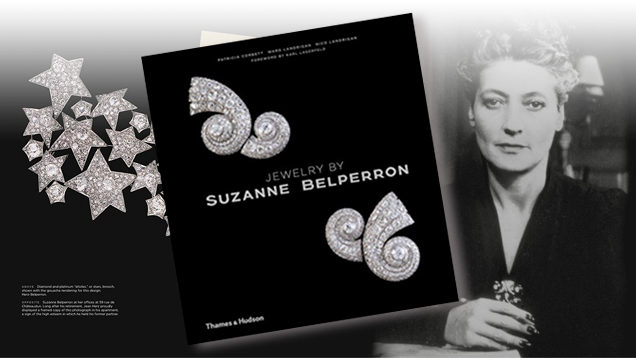Book Review: Jewelry by Suzanne Belperron: My Style is My Signature

Much like the jeweled creations of the designer herself, Jewelry by Suzanne Belperron invites being treasured on many levels. The book profiles a remarkable woman born in 1900 whose talents were recognized at an early age and who, through her drive, artistic commitment, and singularity, attracted enlightened business and creative partners.
It is also a tale of female fortitude in a man’s world, where a young woman from a small town in the Jura Mountains learns a broad range of design skills. Shortly after her 1919 arrival in Paris, Belperron (then known as Suzanne Vuillerme) was hired as a designer-draftswoman by Maison Boivin, one of the city’s few premier jewelry houses. At the age of 32, she aligned herself with Bernard Herz, receiving the allegiance of Groëné and Darde, two of the most renowned Parisian jewelers, along with other jewelers, polishers, and stone setters.
Suzanne Belperron’s saga is also that of a singular individualist, a virtuoso whose style and artistry were so distinctive that she felt no need to sign her work, asserting that her style was her signature. Hardship, an enviable clientele, war, and loss are reflected in Belperron’s jewelry, at once breathtakingly magnificent yet rooted in themes and materials that reveal the soul and sensibility behind her luxurious splendor.
Above all, the jewels reign supreme. Exquisitely captured by photographer David Behl and others, pieces feature Belperron’s sculptural and fluid designs. Scroll, shell, pyramidal, domed, winged, petal, and other motifs are used to embellish carved hardstones, metals, and gems ranging from diamonds, sapphires, rubies, and emeralds to her much-admired chalcedonies and onyx. As one of the innovators of the serti mystérieux, or invisible setting, Belperron used diamonds of varying sizes and relations in her pavé designs. The results are much like the painter’s brushstrokes that evoke movement, depth and highlights. Belperron designs also redefined the parure (matching jewelry sets), providing versatility through diverse elements that could be added or removed to create the desired amount of adornment.
Besides the superb photography, the book includes many of Madame Belperron’s gouache opaque watercolor renderings from Harper’s Bazaar and Vogue covers and features, including Diana Vreeland’s popular and provocative “Why don’t you…” columns that suggested a look illustrated by the wearing of a Belperron piece. Occasional obverse views of breathtaking pieces, such as the deceptively casual setting of a diamond and ruby bib necklace, reveal the intricate platinum links that invisibly grant the piece the appearance of flowing fabric.
Although Belperron’s name may be less familiar than those of many other 20th century jewelers, this book establishes her as one of the most significant jewelers, if not the most notable female jewelry artist, of her time. Testifying to her work’s enchantment was a client list that included royalty, artists, and prominent public figures. The Duke and Duchess of Windsor, Princess Grace of Monaco, Clark Gable, Lauren Bacall and Humphrey Bogart, and members of the Lanvin, Mellon and Paley families all owned pieces by Belperron.
Authors Patricia Corbett and Ward and Nico Landrigan bring to life the masterful body of work displayed in these pages. The authors worked with Belperron’s former partners’ descendants, master craftsmen, collectors, and archivists, among others to bring this book to fruition. Without their efforts, the legacy of Suzanne Belperron may have been lost, much like the artist’s many pieces that have been sold at auction unrecognized and perhaps underappreciated.
The story of Suzanne Belperron is a rich one indeed, worthy of the interest and scholarship of aspiring and established jewelry designers and lapidaries, jewelry historians and all those interested in stories of immeasurable talent, quietly productive introversion, fortitude, and groundbreaking creativity.



